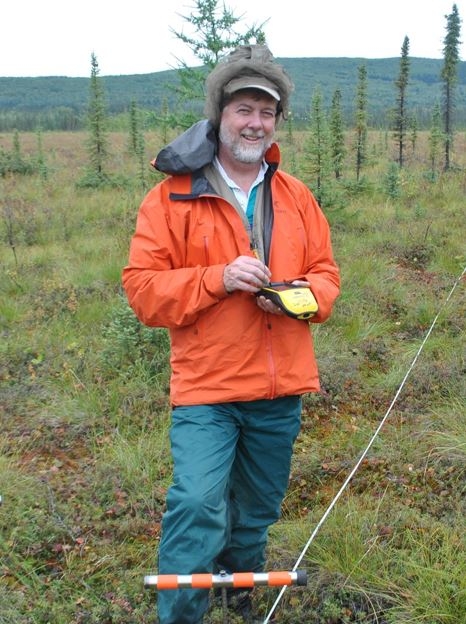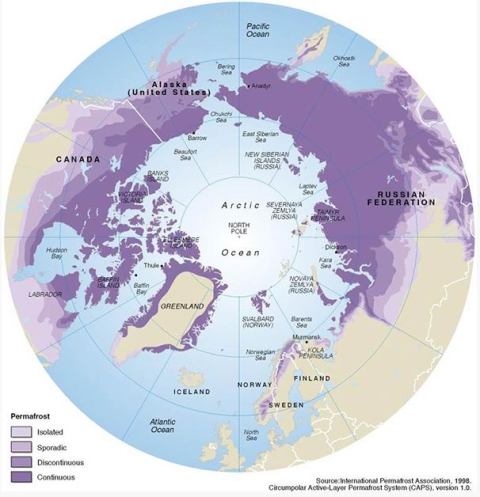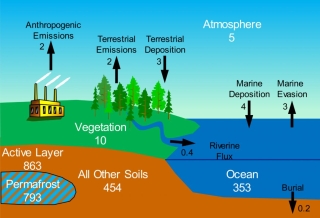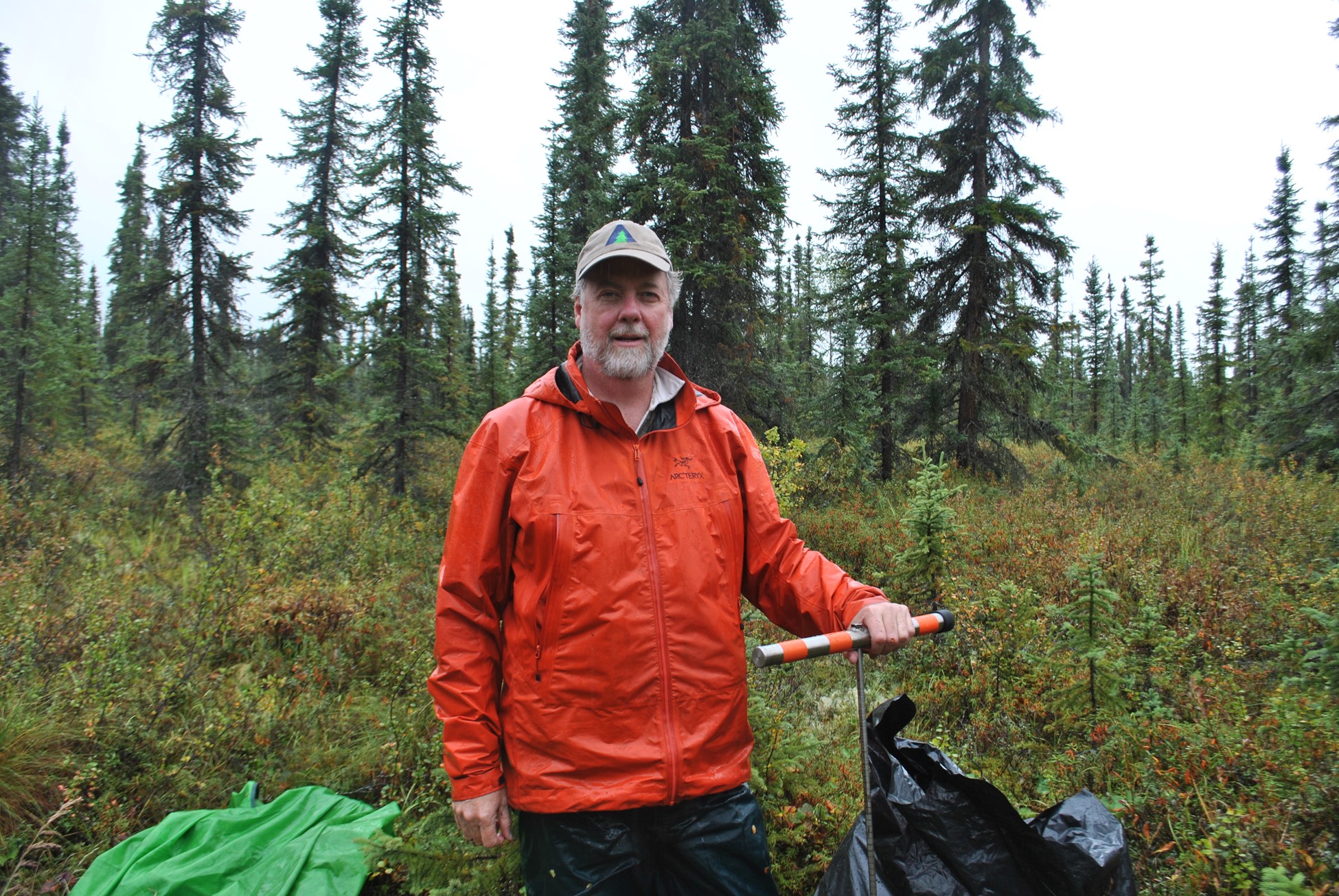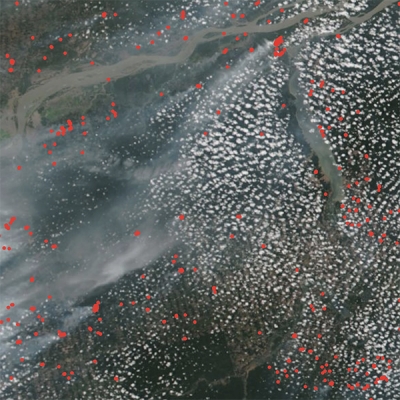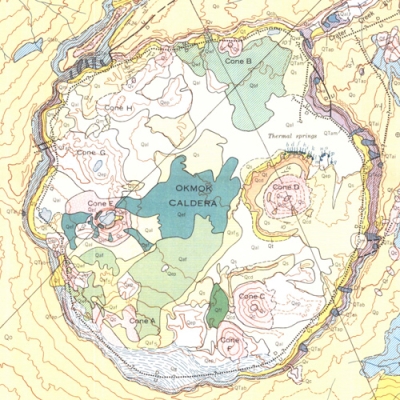Dr. Kevin Schaefer, Research Scientist, National Snow and Ice Data Center, University of Colorado.
Research Interests: Terrestrial biosphere and land surface modeling, biogeochemistry, and soil thermodynamics in the Arctic; remote sensing of active layer thickness; and modelling to predict potential permafrost thaw and estimate the magnitude and timing of the potential release of greenhouse gasses from thawing permafrost.
Research Highlights: The “sleeping giant of climate change”: that’s what some scientists who study Arctic ecosystems think permafrost—the frozen ground consisting of rock, soil, or sediment that remains at or below 0° Celsius for at least two years—could become. And they have good reason to be concerned.
In addition to that rock, soil, or sediment, permafrost also contains a lot of carbon-rich organic material, such as roots, that froze without decaying. As permafrost formed over thousands of years, it has accumulated vast amounts of this organic, carbon-rich material.
In fact, some estimates say Arctic permafrost contains 1,400 to 1,850 billion metric tons of carbon, which is about half of all the estimated organic carbon stored in Earth's soils. In comparison, about 350 billion metric tons of carbon have been emitted from all fossil-fuel combustion and human activities since 1850.
Most of the Arctic’s sequestered carbon is located within the thaw-vulnerable topsoil that resides within 3 meters of the surface, and as scientists are coming to understand, permafrost and all the carbon stored within it may not be as permanent as its name implies. According to the findings of a 2018 NASA-led study, the permafrost in the northern Arctic, once thought to be at least temporarily shielded from global warming by its extreme environment, will thaw in this century. If that happens, the organic material it contains will decompose and release carbon to the atmosphere in the form of the greenhouse gases carbon dioxide (CO2) and methane (CH4), a much more potent greenhouse gas than CO2 (although it does not remain in Earth's atmosphere as long). Further, carbon released into the atmosphere from thawed permafrost could lead to higher temperatures in the region, thereby fueling the cycle of carbon release and temperature rise.
Among the scientists working to detect climate-induced thawing of permafrost on a large-scale is Kevin Schaefer, a Research Scientist with the University of Colorado’s National Snow and Ice Data Center (NSIDC). NSIDC manages and distributes scientific data, creates tools for data access, supports data users, performs scientific research, and educates the public about the cryosphere, and its scientists specialize in the remote sensing of the Arctic’s snow and ice, climate, frozen ground, ice sheets, glaciers, and permafrost.
Frozen ground data are critical to understanding environmental change in the Arctic, and necessary for validating models of seasonal frost and permafrost regions. Schaefer’s research has helped provide some of this data and yielded important results for both the NSIDC and the climate change research community. For example, he and his colleagues pioneered the use of remote sensing techniques to measure thaw depth in permafrost regions—a practice that opened up an entirely new suite of tools for scientists to use in monitoring permafrost dynamics. They published the first global estimate of CO2 and CH4 releases from thawing permafrost and developed new modeling techniques still in use today. They organized several multi-model comparisons that resulted in improved model performance, several simulation datasets, and at least 25 papers. And they made the first estimates of mercury content in permafrost and of potential mercury releases from thawing permafrost. Prior to these estimates, the scientific and policy community was unaware that permafrost contained more mercury than the atmosphere, ocean, and Earth’s surface combined.
In addition to his position with the NSIDC, Schaefer is also a member of NASA’s Oak Ridge National Laboratory Distributed Active Archive Center (ORNL DAAC) User Working Group (UWG). Established in 1993 by an interagency agreement between NASA and the Department of Energy (DOE), ORNL DAAC ingests, processes, archives, and distributes data products tools, and resources in NASA’s Earth Observing System Data and Information System (EOSDIS) collection pertaining to terrestrial biogeochemistry, ecology, and environmental processes. It also provides Schaefer, his NSIDC colleagues, and researchers around the globe with access to several datasets critical to their work in the Arctic.
“We use airborne Synthetic Aperture Radar (SAR) data from NASA’s Arctic Boreal Vulnerability Experiment (ABoVE) field campaign, airborne and satellite lidar data, and Moderate Resolution Imaging Spectroradiometer (MODIS) products, all of which are essential elements of our research into permafrost dynamics,” he said. “We use the SAR data to measure soil moisture, surface heave as the ground freezes, and thaw depth. We use lidar data to measure surface topography, from which we estimate the thickness of permafrost, and we use MODIS products of absorbed visible light, leaf area index, and estimated rates of photosynthesis as input to and as validation of land surface models.”
For example, in 2018, Schaefer co-authored a paper published in Geophysical Research Letters that found thawing permafrost in the Northern Hemisphere stores twice as much mercury as the rest of the planet’s soils, atmosphere, and oceans—a finding with significant implications for human health and ecosystems worldwide. Schaefer, along with the study’s lead author, Paul Schuster of the USGS, and others measured mercury concentrations in cores of permafrost from Alaska and used the data to estimate how much mercury has been trapped in Northern Hemisphere permafrost since the last Ice Age. They found that the Northern Hemisphere’s permafrost regions contain an estimated 1,656 gigagrams of mercury (32 million gallons), making them the largest known reservoir of mercury on the planet. This amount is nearly twice as much mercury that found in the ocean, the atmosphere, and terrestrial areas outside the permafrost region combined. These findings are significant as mercury, a naturally occurring element in the Earth’s crust, could have a negative impact on the environment if large concentrations are released.
“As long as the permafrost remains frozen, the mercury will stay trapped in the soil,” said Schaefer in a NSIDC press release about the research. “Higher air temperatures due to climate change could thaw much of the existing permafrost, allowing the decay of organic matter to resume and releasing mercury that could affect Earth’s ecosystems. The released mercury can accumulate in aquatic and terrestrial food chains and cause harmful neurological and reproductive effects on animals.”
The researchers determined the amount of mercury in permafrost by taking in situ measurements at various sites in Alaska between 2004 and 2012 and then compared their measurements with data on mercury in non-permafrost and permafrost soils from thousands of other sites worldwide. They used their observed values to estimate the total amount of mercury stored in permafrost in the Northern Hemisphere and to create a map of soil mercury concentrations in the region.
In 2020, Schaefer was the lead author on a related study published in Nature Communications, Potential Impacts of Mercury Released from Thawing Permafrost,. In which he and his colleagues used the Simple Biosphere/Carnegie-Ames-Stanford Approach (SiBCASA) model to estimate the potential future releases of mercury from thawing permafrost in both low and high greenhouse gas emissions scenarios. Their results indicate minimal impacts to mercury concentrations in water and fish for the low emissions scenario and high impacts for the high emissions scenario.
Schaefer also participated in research that used interferometric Synthetic Aperture Radar (InSAR) data to measure permafrost thickness in the Yukon-Kuskokwin (YK) delta region in Southwest Alaska. Many wildfires have occurred in the YK delta between 1971 and 2015, impacting the region’s vegetation cover, surface soil moisture, and the permafrost’s active layer (the ground layer above permafrost that thaws in the summer and refreezes in winter). After generating a stack of interferograms over the region from 2007 to 2010, the researchers then applied the remotely sensed active layer thickness (ReSALT) algorithm to the interferograms to measure the seasonal subsidence associated with the freezing and thawing within the active layer, as well as the subsidence trends associated with wildfire. In doing so, the researchers identified two wildfire-induced subsidence signatures, associated with the active layer and the permafrost layer, thereby demonstrating that InSAR is sensitive to increases in active layer thickness following wildfire. The results of this research, which were published in Environmental Research Letters in 2019, found that the active layer recovers to pre-fire values after approximately 25 years and that fire gradually thins the permafrost layer by 4 meters, which recovers to pre-fire thickness after 70 years.
More recently, Schaefer, lead author Leah Clayton of Yale university, and others published a paper detailing an investigation of how soil moisture influences permafrost active layer thickness, an important metric for monitoring permafrost. One hypothesis suggests that increased soil moisture would facilitate increased energy flow into the soil and thus result in a deeper active layer. The alternate hypothesis suggests frozen soils with high ice content would require more energy to thaw, resulting in a shallower active layer. To investigate the influence of these hypotheses on thaw depth, Schaefer and his fellow researchers analyzed the Soil Thaw Depth and Moisture (STDM) dataset from the ABoVE field campaign, which consists of thousands of measurements of thaw depth and soil moisture collected at dozens of sites across Alaska and Canada. Their analysis suggests that, overall, latent heat exerts a stronger control on active layer thickness than thermal conductivity. However, they reported that both mechanisms occur simultaneously at different depths throughout the soil column. Further, their analysis also indicates a need for scientists to explore new techniques and strategies for measuring bulk soil moisture content when studying its relationship with active layer thickness.
These findings about the qualities and characteristics of permafrost, the impact of soil moisture on permafrost’s active layer, and the effect of thawing permafrost may pose to ecosystems and the climate are significant. Scientists have found that permafrost in the northern Arctic has already begun to thaw, and additional thawing expected this century. Air temperatures in high-latitude regions are increasing at twice the global rate, which threatens the distribution and stability of permafrost regions, and field observations indicate that permafrost has already warmed by up to 6°C during the 20th century. Further, a 2005 permafrost projection using the Community Climate System Model, version 3 (CCSM3) suggested that, by 2100, as little as 1 million square kilometers of near-surface permafrost might remain. Undoubtedly, this thawing will result in dramatic environmental change to the Arctic. Fortunately, the work of Schaefer and his NSIDC colleagues—work that relies on the Earth science data NASA EOSDIS collects—will support the climate research community’s efforts to better understand these changes, their consequences, and how me might address them.
Representative Data Products Used or Created:
Available through ORNL DAAC:
- ABoVE: Active Layer Thickness Derived from Airborne L- and P-band SAR, Alaska, 2017
doi:10.3334/ORNLDAAC/1676 - Synthesis of Winter in Situ Soil CO2 Flux in pan-Arctic and Boreal Regions
doi:10.334/ORNLDAAC/1692 - NACP MsTMIP: Global 0.5-degree Model Outputs in Standard Format, Version 1.0
doi:10.3334/ORNLDAAC/1225 - Soil Moisture and Active Layer Thickness in Alaska and NWT, Canada, 2008-2020
doi:10.3334/ORNLDAAC/1903 - MODIS Products
https://modis.ornl.gov/data.html
Other data products used:
- Projections of permafrost thaw and carbon release for RCP4.5 and RCP8.5, 1901-2299 (University of Alaska-Fairbanks, Institute of Arctic Biology)
doi:10.6073/pasta/4edb926a2ecbfc90633d7a9927488a39 - Climatic History of the Northeastern United States During the Past 3000 Years (EDI Data Portal)
doi:10.6073/pasta/6ced33c5e07f9fa7f11efb259001bacb - Total mercury, bulk density, percent organic matter, and percent organic carbon measured in permafrost cores from the interior and northern slope of Alaska and previously published studies (USGS)
doi:10.5066/F7NC5Z9T
Read about the Research:
Clayton, L.K., Schaefer, K., Battaglia, M.J., Bourgeau-Chavez, L., Chen, J., Chen, R.H., Chen, A., Bakian-Dogaheh, K., Grelik, S., Jafarov, E., Liu, L., Michaelides, R.J., Moghaddam, M., Parsekian, A.D., Rocha, A.V., Schaefer, S.R., Sullivan, T., Tabatabaeenejad, A., Wang, K., Wilson, C.J., Zebker, H.A., Zhang, T., & Zhao, Y. (2021). Active layer thickness as a function of soil water content. Environmental Research Letters, 16, 055028. doi:10.1088/1748-9326abfa4c
Schaefer, K., Elshorbany, Y., Jafarov, E., Schuster, P.F., Striegl, R.G., Wickland, K.P., & Sunderland, E.M. (2020). Potential impacts of mercury released from thawing permafrost. Nature Communications, 11, 4650. doi:10.1038/s41467-020-18398-5
Michaelides, R.J., Schaefer, K., Zebker, H.A., Parsekian, A., Liu, L., Chen, J., Natali, S., Ludwig, S., & Schaefer, S.R. (2019). Inference of the impact of wildfire on permafrost and active layer thickness in a discontinuous permafrost region using the remotely sensed active layer thickness (ReSALT) algorithm. Environmental Research Letters, 14. doi:10.1088/1748-9326/aaf923
Schuster, P.F., Schaefer, K., Aiken, G.R., Antweiler, R.C., Dewild, J.F., Gryziec, J.D., . . . Zhang, T. (2018). Permafrost stores a globally significant amount of mercury. Geophysical Research Letters, 45: 1463-1471. doi:10.1002/2017GL075571
